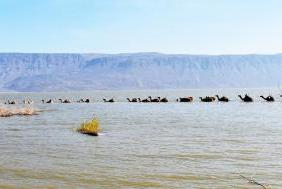
The NILAFAR program proposes to study the impact of hydrological fluctuations on societies in NE Africa over the last 20,000 years and in particular on the development of pastoralism. NILAFAR also aims to better understand the climatic mechanisms at the origin of the fluctuation intensity of the African monsoon (external forcing and internal feedbacks of the climate system), and at the origin of short hyperarid episodes. During the African Humid Period (AHP) these episodes saw the retraction or dissemination of particularly mobile human groups. In an environment that may have been as limiting as it was stimulating due to the alternance of these hyperarid and wet phases, populations innovated using new economic strategies, shifting from a predation to a production economy.
NILAFAR proposes to explore the correlation between paleo-hydrological regimes and the evolution of these anthroposystems in the Afar valley in Ethiopia and Djibouti. The AHP will be revisited using innovative inorganic and organic tools that allow a quantification of hydrological variations of lakes and chemical alteration of Ethiopian soils at high temporal resolution (~100 years). In this context, we will study the Afambo, Gamari and Abhe Lakes and their watersheds as they have high-resolution records of major monsoon and environmental changes that occurred from the late Pleistocene (pre- 11.7 ka) to the Early Holocene (pre- Anthropocene).
The originality of the project is its disciplinary and human synergy that combines different fieldwork approaches in the Afar region (archaeology, coring of Abhe basin lake sediment, geomorphology, cartography), a reconstruction of human settlement patterns and paleoeconomy by combining the study of morphosedimentary archives and archaeomaterials, hydro-climatic modelling, and a reconstruction of hydrological fluctuations by coupling innovative (lithium isotopes, biomarkers) and classical analytical tools (neodymium isotopes, diatoms and hydrochemical transfer functions). The establishment of robust age models, both for lake and soil archives and for successive human occupation sequences will be a priority as our preliminary results are very promising. Large-scale climate simulations will be used to study the mechanisms of monsoon change during the last deglaciation/Holocene, and a rain-flow model will be developed to better understand the changes in the flow of the Awash River which drains this zone and also in the flow of the Blue Nile. These models, which have been tested on a large number of past climates and hydrologies, will act as excellent tools to predict future hydrological and climatic variations at the scale of this region. Finally, Human-Ecosystem-Climate coevolution will be explored over this wide chronological sequence.
The ultimate objective of this project is to propose solutions for populations to better adapt to the agro-pastoral and water resource challenges of our societies, of first order in countries such as Ethiopia and Djibouti which are facing infrastructure development. We will train students and future researchers to understand global warming mechanisms and to cautiously predict the future of arid regions. This transmission of knowledge will take place over four years with a request for two post-doctoral positions in archeology and modelling and a PhD thesis for the acquisition of innovative data. This project will also provide an opportunity to strengthen the training of Ethiopian students in the field and in geochemistry through joint university courses.
PIs: Marie Revel, Lamya Khalidi, Nathalie Vigier, Guillemette Ménot & Laurent Bruxelles
Partners: Pierre Brigode, Sébastien Migeon, Pascale Braconnot, Masa Kageyama, Françoise Chalié, Florence Sylvestre, Fabien Arnaud, Eric Chaumillon, Maryline Montanes, Jérémy Jacob, Jessie Cauliez, Gourguen Davtian, Marzia Gabriele, Joséphine Lesur, François Bon, Clément Ménard, Louise Purdue, Lucie Coudert et Carlo Mologni
Dates : 2021-2025
Fundings: ANR PRC 2021, 560k€
NILAFAR website : https://geoazur.oca.eu/fr/anr-nilafar




